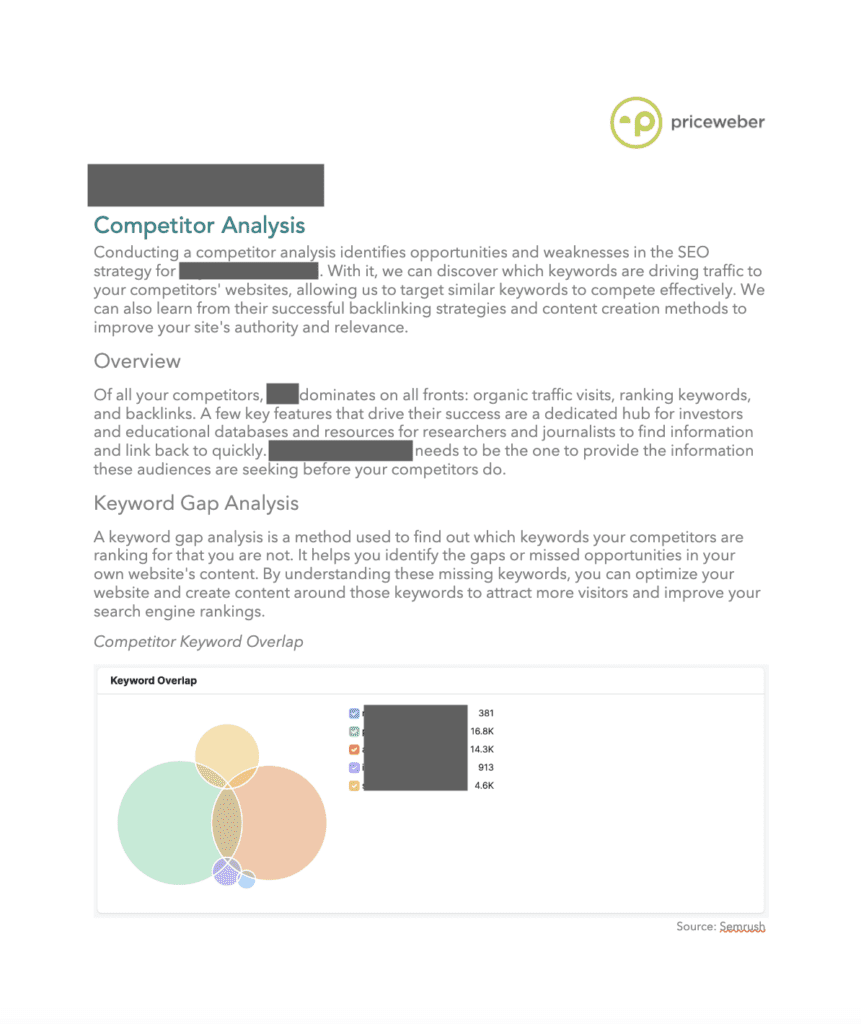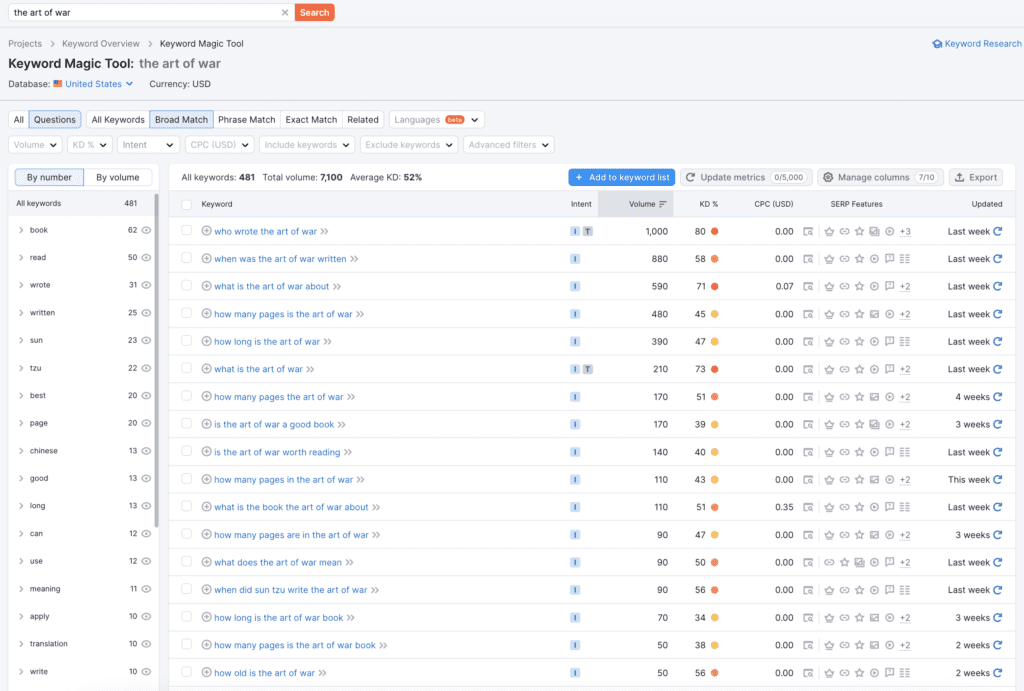
The SEO Competitor Analysis: How To Use SEO for Competitive Blunting
As Sun Tzu so eloquently stated in The Art of War, “If you know the enemy and know yourself, you need not fear the result of a hundred battles.” This ancient wisdom still resonates today, but perhaps not in the way Tzu envisioned. When it comes to SEO and digital marketing, knowing your competition can mean the difference between smashing success and devastating defeat.
But take heart. You need not fear the search results of a hundred organic competitors ranking above you. (See what I did there?) In this edition of Plain Talk, we’ll discuss competitive blunting through an SEO lens. We’ll also explore how to leverage an SEO competitor analysis and creative strategies to help you conquer your corner of the digital realm.
- What Is Competitive Blunting?
- Understanding SEO Competitiveness
- The SEO Competitor Analysis: Your Secret Weapon
- Counter-Strategy Ideas to Blunt Your Search Competition
- Get Expert Help With Your SEO Competitor Analysis
What Is Competitive Blunting?
In business strategy, competitive blunting means creating defenses against competitor actions to reduce their impact and keep your market position strong. In the 90s, when Pepsi tried to re-enter the post-apartheid South African market, Coke controlled all of the local bottlers. Coke even went so far as to pay more for Pepsi’s reusable bottles, pulling them out of inventory, and smashing and recycling them. While this level of competitive blunting seems ruthless and ethically questionable, it doesn’t have to be so Machiavellian.
In the context of SEO, this same concept—with the aim of diminishing the visibility and effectiveness of competitors’ efforts on search engine results pages (SERPs)—can be achieved by effectively creating noise or positions counter to theirs. Almost no two brands compete exactly the same. Competitive blunting is really about diminishing your competitors’ efforts.
This competitive strategy helps businesses enhance their own perception and attract organic traffic. It also increases the chances of capturing traffic from competitors. By diminishing competitors’ search positions and perceptions, businesses can gain a significant advantage.
Understanding SEO Competitiveness
Search engine results pages (SERPs) are the battleground where businesses vie for visibility and supremacy. In fact, competitive blunting is fairly common on SERPs. Marketers have bought top positions for their competitors’ names for years, but now we are looking to address it with organic results as well.
In order to get in front of the right eyeballs at the right time, websites continually jockey for attention, relevance, and, ultimately, clicks. If you’re investing in SEO, you’re already aware of how tricky this can be. The struggle to secure a prime position once a searcher types in their query and hits Enter/Return is real.
Being competitive in SEO encompasses an array of factors, ranging from keyword targeting and content quality to backlink profiles and site authority. Here are the main components that play into crushing the competition.
- Keywords and search intent: Keywords serve as the cornerstone, with their relevance, intent, and search volume dictating the intensity of competition within a niche.
- Content: Content quality, enriched by depth, relevance, and engagement, is an integral part of SEO competitiveness.
- Backlink profiles: Backlinks are like digital endorsements from other websites, giving authority and credibility to the sites they link to.
- Site authority: This measure of trust, credibility, and influence a website holds within its niche or industry impacts its ranking potential in search engine results.
- Website design and performance: Factors like site speed, user experience, and mobile-friendliness are an important part of the competitive landscape, with optimization being the top priority.
The SEO Competitor Analysis: Your Secret Weapon
Now that you understand the critical components, how can you gain valuable insights into what works, what doesn’t, and where you can make your mark? Enter the competitor analysis. An SEO competitor analysis is a deep dive into enemy intel, so to speak. By identifying competitive threats and uncovering opportunities, SEOs can develop marketing strategies to help businesses like yours gain a competitive advantage in SERPs.
SEO competitor analysis checklist
When conducting a competitor analysis, the SEO team at PriceWeber reviews your website against your competitors’ websites using the following checklist. We use a combination of software and tools, including Semrush, Screaming Frog, Google Analytics, and Google Search Console—not to mention some good old-fashioned detective work—to gather this information and build our report. These insights can also be utilized to shape marketing campaigns and strategies across the board.
Keyword gap analysis
A keyword gap analysis is a method used to find out which keywords your competitors are ranking for that you are not. It helps you identify the gaps or missed opportunities in your own website’s content, especially if you’ve launched a new product or service similar to what a competitor offers.

Content strategy analysis
This analysis evaluates the content strategies employed by rival websites within the same industry or niche. It includes examining aspects such as the types of content produced, keyword targeting, content themes, depth and quality of content, and frequency of updates.
Traffic analytics
Traffic analytics looks at the web traffic patterns and metrics of your competitors’ websites. It involves data on how much traffic their websites receive, where the traffic is coming from and where it’s going, how long visitors stay on their site, and more.
Website performance audit
This audit typically includes reviewing factors such as site speed, accessibility, crawlability, mobile responsiveness, internal linking, and more. Understanding how your site is performing can help uncover underlying technical issues that may be affecting your ability to rank higher than your competitors.
Backlink profile
A backlink profile refers to the collection of all the incoming links pointing to a competitor’s website from other websites across the internet. These incoming links are also known as backlinks or inbound links. Backlinks are important because they indicate the credibility and authority of a website.
Counter-Strategy Ideas to Blunt Your Search Competition
Armed with your competitor analysis, there are several strategies you can implement over time to steal keywords away from the companies that are currently outranking you. Here are a few ideas to consider as you craft your overall content digital marketing strategies.
Skyscraper link-building technique
The skyscraper technique involves identifying high-performing content in your industry, creating similar but improved content, and then actively promoting it to attract backlinks and increase visibility.
“Ranch-style” SEO technique
An alternative to the skyscraper technique is the ranch-style approach, developed by Clearscope founder Bernard Huang. This involves splitting competitor-targeted content out as granularly as possible—ideally targeting several search perspectives—as opposed to having one single piece of skyscraper content. This technique is especially helpful with the rise of AI-assisted search.
Hot-on-your-heels keyword targeting
Look at keywords you and your competitors share. Is there one that they’re ranking for in the top 10, but you’re right behind them in positions #11-20? Compare your page to theirs and then make yours better.
Low-hanging fruit keyword targeting
Research long-tail keywords based on questions or niche topics related to your business that competitors may have overlooked and develop content around those. Keyword research tools like Semrush or Answer the Public are great for this.

Thought leadership link-building technique
Drive traffic to your site and rank higher in SERPs by publishing topical content generated by an in-house subject matter expert (SME) and pushing it out to media outlets.
Newsjacking link-building technique
Using this technique means developing content around a current news event or pop culture phenomenon to capture trending keywords and leave your competition in the dust.
Reverse digital PR link-building technique
This tactic involves creating content and data hubs that journalists need to write stories and having them come to (and cite) your website instead of your competitors’ website.
Negative SEO: Don’t Fight Dirty
While researching ways to take on organic competitors, you may come across a quick-fix approach called negative SEO. Negative SEO uses unethical tactics to sabotage a competitor’s search engine rankings. It can include:
- building spammy backlinks to the target site
- creating duplicate content
- fake link removal requests
- generating fake negative reviews
- engaging in social media defamation
- hacking the target site and injecting malicious content, spammy or irrelevant links (link injections), phishing pages, or keyword stuffing to encourage blacklisting from search engines
Is it illegal? Aside from hacking or outright stealing content, unfortunately not. In fact, there is certainly no shortage of companies willing to implement just about any of these practices (legal or not) on your behalf for the right price. But is it the right thing to do? That’s up to you to decide. Personally, I’d recommend doing the right thing and keeping your SEO practices above board.
Get Expert Help With Your SEO Competitor Analysis
Don’t forget to keep performing recon on the competition and be ready to adjust your strategies as needed. SEO is constantly changing. There are always search engine algorithm updates and new tactics to contend with. Whether it’s shifts in popular keywords or search intent, changes in how people engage with content, or updates to backlink strategies—stay vigilant. You can bet your competitors are. By being adaptable and responsive, you can make sure your SEO efforts capture more of the market share and capture new customers away from the other guys.
If you’re ready to go to war against your organic competitors, PriceWeber is here to help draw up the battle plans, so drop us a note or call us at 502-499-4209. Our team specializes in helping to tailor SEO and digital advertising solutions backed by thorough competitor analysis and best practices. Let us help you hone your organic search edge and take down the SEO competition.
Our Articles Delivered
Signup to receive our latest articles right in your inbox.




